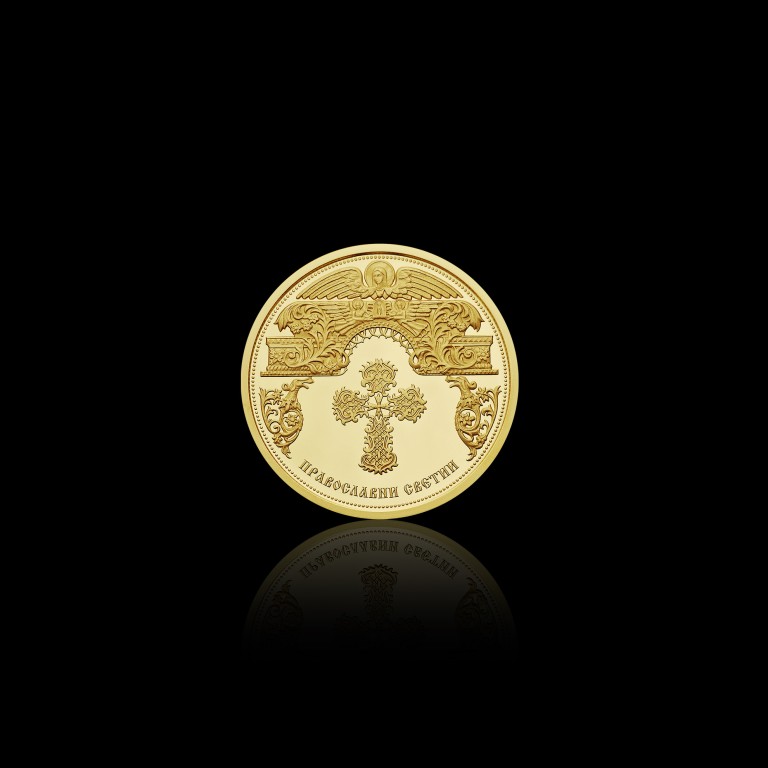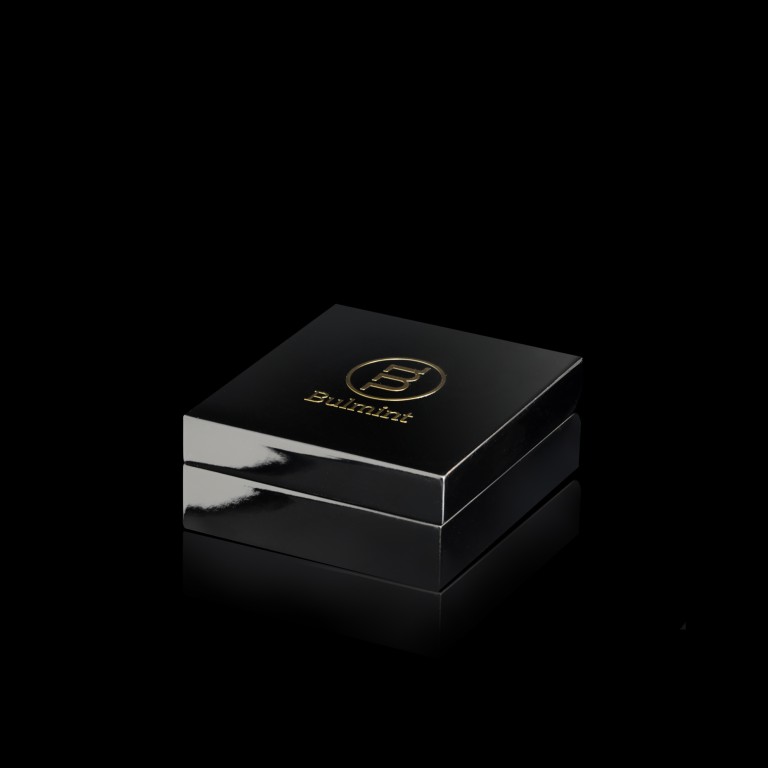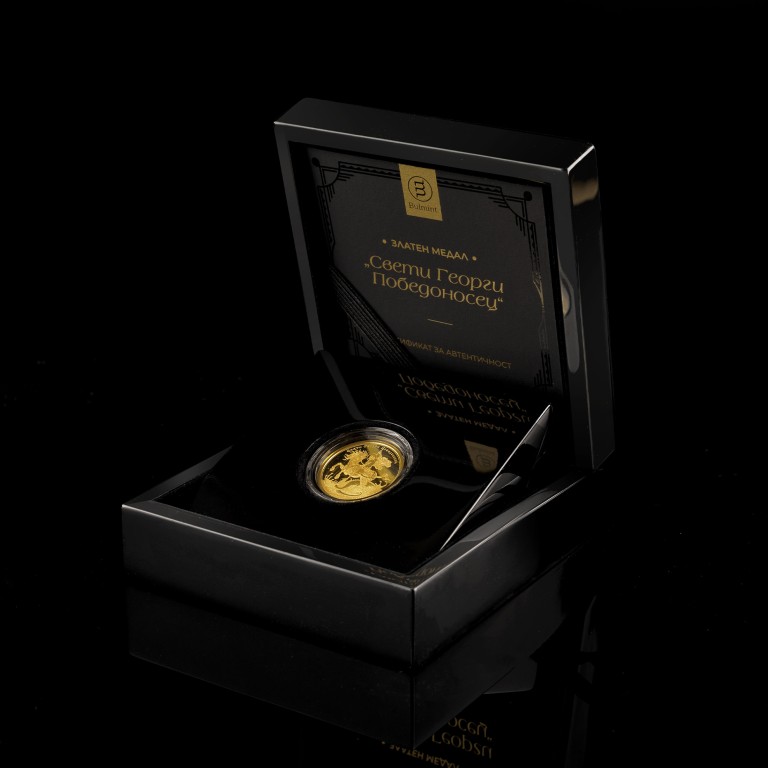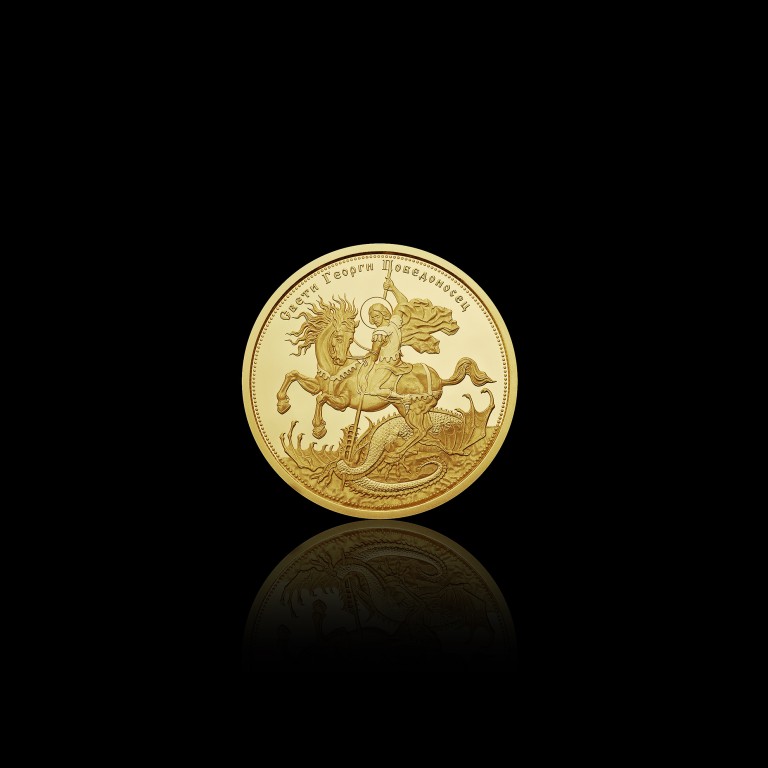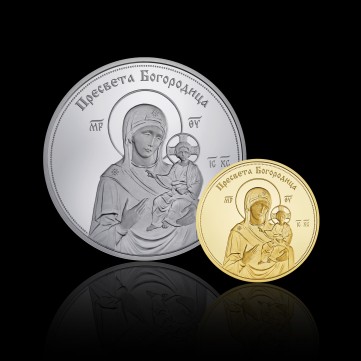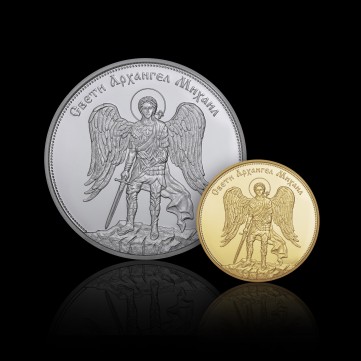Saint George is one of the most highly venerated saints in Eastern Orthodox Christianity. The image of his mythical victory over the dragon is deeply ingrained in cultures all over the world. Out of all Christian feast days, Saint George's Day is held in particularly high regard in Bulgaria - it also doubles as Bulgarian Armed Forces Day.
The first collection in our "Orthodox Saints" program is dedicated to Saint George - patron saint of shepherds and divine protector of warriors and military men.
The Saint George gold medal is minted in proof matt-gloss quality out of 7.78 g of 999.9 fine gold. It has a diameter of 24 mm, via a classic coin minting technology. The design features a dynamic illustration of the saint on horseback, slaying a dragon with his lance - a metaphor for the Devil's defeat at the hands of God's soldier.
To capture the emotional impact of the scene, we selectively applied a special satin finish. Saint George’s armour, the straps of his steed’s saddle and the dragon’s scales hold a captivating gleam under a certain light, adding an additional mythical effect to the scene.
The design of the reverse is inspired by the gilded iconostasis of the Nativity of the Blessed Virgin Mary Church in Rila Monastery - a stunning example of Revival Period woodcarving made in 1839 by Atanas Teladur, the founder of the woodcarving movement of the Samokov Art School. We recreated the hand-carved ornaments as beautifully crafted silver art pieces by using contemporary coin-minting technology. The centerpiece of the composition is a detailed Eastern Orthodox cross.
You receive the product in a luxury box.
Have a look at the silver-proof medal with the same design. You may also opt to buy the Saint George medal collection as a set.
Metal
Fine Gold
Weight
7.78
g
Purity
999.9/1000
Edging
Smooth
Quality
Proof
Circulation
1000
pcs.
Diameter
24
mm
The life of St. George
The Christian tradition attributes a number of miraculous acts to the saint - the Biblical tales state that God extended his protection to him during his torture, that he was healed and resurrected multiple times during the torment, and that he himself performed miracles, inspiring a number of the emperor's own loyalists to convert to Christianity.
Saint George and the Dragon
The events of this legend were first attributed to Saint George in the 11th century, but its roots likely predate Christianity - there are analogous stories dating back to Ancient Greece, most famously the story of Perseus and Andromeda. It has even been associated with other Christian saints. The iconography itself - the warrior saint on horseback - is the successor to the image of the Thracian horseman, a motif commonly used in Rome, Ancient Greece, and, of course, Thrace. Other Christian saints depicted this way include Saint Theodore Tiron, Saint Demetrius and Saint Mina. The Christian interpretation of this legend is that it allegorizes the saint's defeat over the Devil, often depicted as a serpent, and later - as a dragon.
This legend is what earned him the titles The Victorious and The Triumphant, widely used in Eastern Orthodox Christianity.
Feasts and veneration
In the Bulgarian cultural calendar, the year is divided into two halves - summer and winter. Saint George's Day marks the beginning of summer. In some regions, this day surpasses even Easter in its significance. The centerpiece of the customs practiced in its honour is a feast of roast lamb, accompanied by singing and dancing, religious rites and rituals performed to bring good health and abundance throughout the year.
In 1880, Knyaz Alexander I Batenberg gave Saint George's Day its other meaning - Bulgarian Armed Forces Day. Today this holiday is celebrated with military parades and demonstrations all over the country.
The saint is also venerated in the Islamic world as a prophet and patron of monotheistic religions.
We dedicated this program to the saints thousands of Christians turn to with prayers of good health and protection, aid and spiritual guidance. It will consist of 12 medal collections dedicated to 12 holy men and women central to Eastern Orthodox Christianity. Each motif will be struck to proof matt-gloss quality onto two medals made of the finest gold and silver.
The number 12 itself is steeped in symbolic meaning - it bears significance in every corner of the world and in more than one religion or culture. That is how many months there are in a year according to most calendars. Its significance is especially pronounced in the Christian Bible. There are twelve holy apostles in the New Testament - chosen confidants and students of Jesus Christ, who were the ones to spread his gospel. The days between the Nativity of Christ and Epiphany are also twelve. Eastern Orthodox Christianity observes twelve Great Feasts - each dedicated to a pivotal moment in the life of Jesus Christ or the Virgin Mary, second in significance only to Easter.
The reverse design shared by the medals in this collection draws inspiration from the gilded iconostasis from the Nativity of the Blessed Virgin Mary Church in Rila Monastery - a composition of richly ornamented woodcarvings depicting floral ornaments, stylised animals and angels. This iconostasis was made between 1839 and 1844 by the master woodcarver Atanas Teladur, founder of the woodcarving movement of the Samokov Art School.
The iconostasis holds a place of high importance in interior church architecture - it represents the divide between Heaven and Earth. It acts as a partition between the altar, to which only members of the clergy have access, and the congregation. It is also the frame upon which the majority of the church icons are hung. The Orthodox churches of Bulgaria, particularly the ones from the National Revival Period, are known for their intricate hand-carved wooden iconostasеs, each steeped in Christian symbolism and local folk motifs.
We ship our orders with Econt Express. The cost of delivery is at the customer's expense and includes insurance, cash on the delivery fee, if applicable, and courier service. The total delivery cost is formed based on the chosen method of payment and the method of delivery.
Orders received by 3 p.m. on working days and chosen payment method cash on delivery or credit card are processed and shipped on the same day. Orders received after 3 p.m. or during the weekend, are processed and dispatched on the next working day.
Each shipment has the "Check" option. In case the customer decides to return the order, the delivery and return costs are at the expense of the customer.
Product is out of stock
Enter your e-mail address and we will notify you when the product is back in stock.

